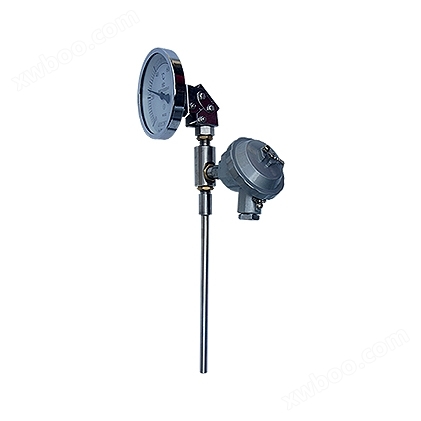
Wanxiang BeltRemote transmission bimetallic thermometer manufacturerThe universal belt remote transmission bimetallic thermometer is an on-site detection instrument for measuring low and medium temperatures. It can directly measure the temperature of liquid vapor and gas media within the range of -80 ℃ to+500 ℃ in various production processes. The main component of industrial bimetallic thermometers is a multi-layer metal sheet composed of two or more metal sheets stacked together, which works based on the principle that two different metals expand differently when the temperature changes. It is composed of bimetallic sheets wound into a circular curved shape. When one end expands due to heat, it drives the pointer to rotate, and the working instrument displays the temperature value corresponding to the thermoelectric potential.
Introduction to the usage method of universal remote transmission bimetallic thermometer
When selecting a bimetallic thermometer, it is necessary to fully consider the actual application environment and requirements, such as dial diameter, accuracy level, installation and fixing method, type of measured medium, and environmental hazards. In addition, it is also important to pay attention to factors such as cost-effectiveness and maintenance workload. In addition, the following points should be noted during the use of bimetallic thermometers:
1. The length of the bimetallic thermometer protection tube immersed in the measured medium must be greater than the length of the temperature sensing element. Generally, the immersion length is greater than 100mm, and the immersion length for the 0-50 ℃ range is greater than 150mm to ensure measurement accuracy.
2. Various bimetallic thermometers are not suitable for measuring the temperature of media in open containers, and live contact thermometers are not suitable for use in control circuits with high working vibration.
3. During the storage, installation, and transportation of bimetallic thermometers, collision with the protective tube should be avoided, and the protective tube should not be bent or deformed, and the thermometer should not be used as a wrench.
4. Bimetallic thermometers should be regularly inspected under normal use. It is generally recommended to do so every six months. Electric contact thermometers are not allowed to operate under strong vibrations to avoid affecting the reliability of the contacts.
5. The temperature at which the instrument frequently operates should be within 1/3 to 2/3 of the scale range.

